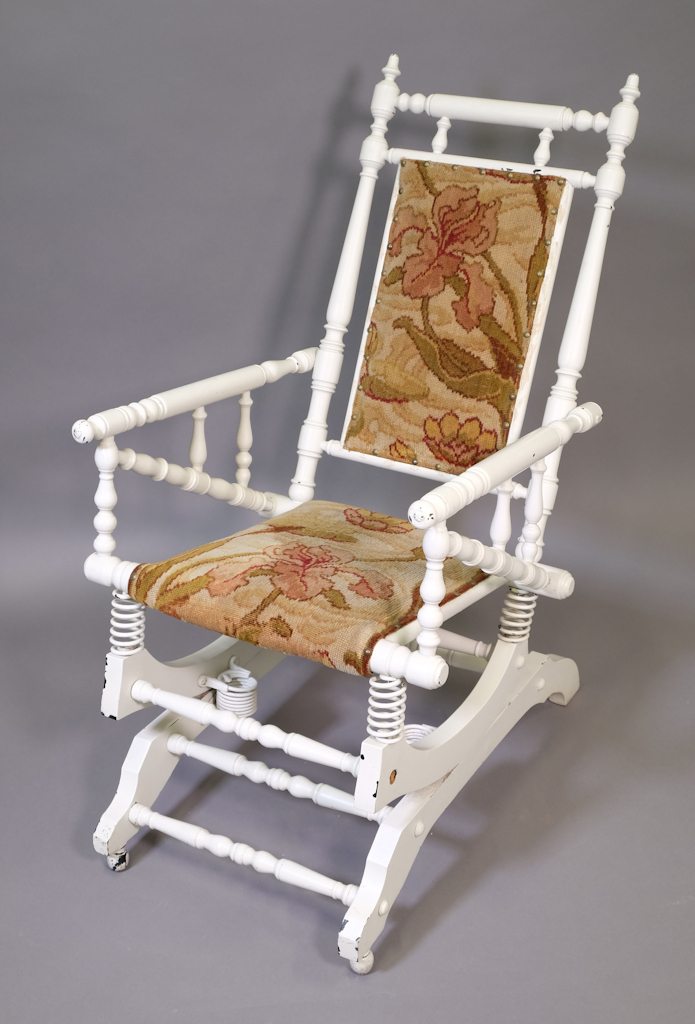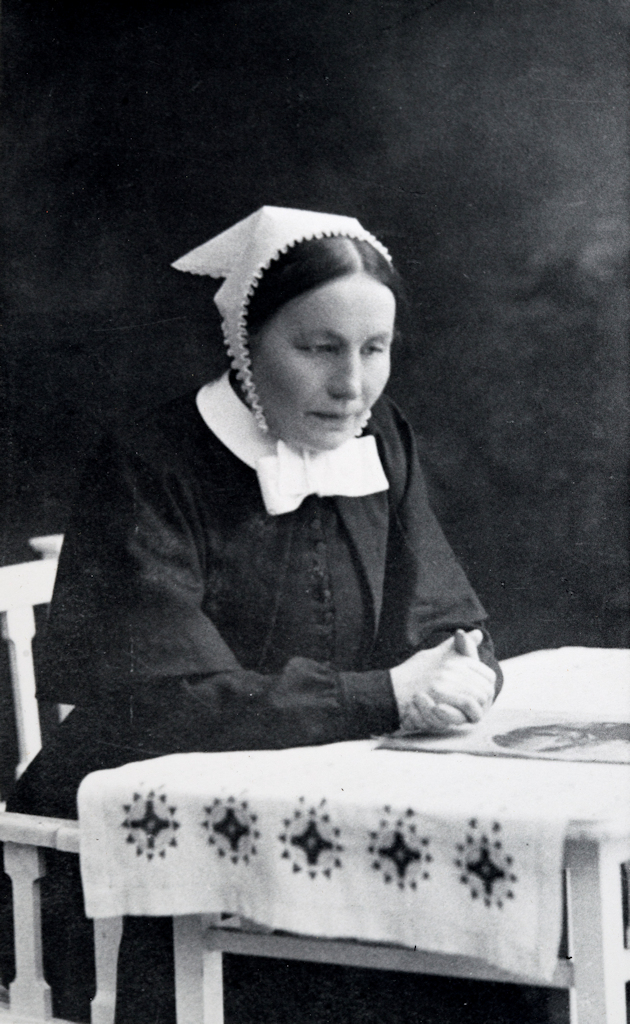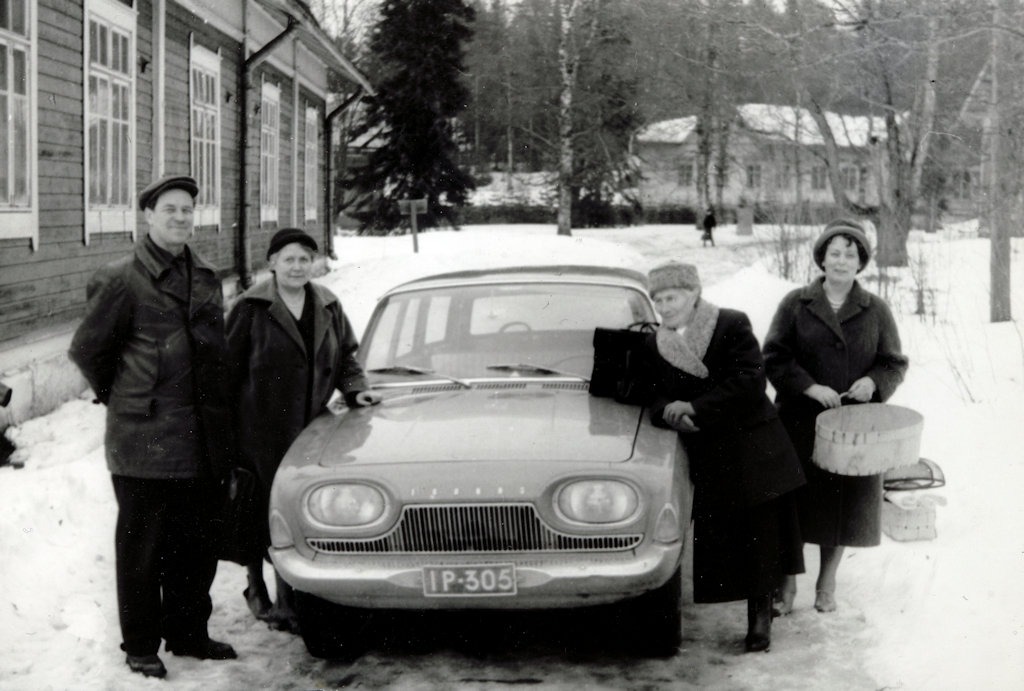The object of the month in March is a white, sprung rocking chair. The chair is lightly padded with a fabric that features big, bold flowers on a light brown background. Being a museum object, the chair cannot be sat on, but it seems comfortable and ergonomic even to modern eyes. The chair was used by deaconess Matilda Hjon (1877–1967), who was a brave and persistent organiser, humanitarian and director.

Becoming a deaconess
When 27-year-old circulating-school teacher Matilda Hjon applied to the Helsinki Deaconess Institute, she wrote: “My most fervent wish is to become a student at the Deaconess Institute.” Her first application was unsuccessful, but she did not give up. Instead, she applied again and was admitted in September 1905.
During the first year, she completed a student course, cleaned and ironed, and worked in the kitchen and dining room of the institute hospital. After about a year, she became a novice, serving in the operating room and children’s ward of the institute hospital. She also worked outside the institute, for example, at the Kumpula State Hospital for Venereal Diseases and the Surgical Outpatient Clinic. Even as a novice, Matilda Hjon was highly intelligent, productive and independent. After completing the duties of deaconess for four years in the Tampere Mission, she was officially inducted as a deaconess in 1912. The induction included the swearing of an oath to dedicate oneself in service to the suffering.
Sister Matilda continued her work in Tampere. She organised women’s diaconal work and strived to expand the sisters’ job description. Deaconesses tended to the sick, distributed food, and held workshops and sewing circles. Sister Matilda’s special responsibility was to support women’s employment. She was also responsible for bookkeeping, which she did at night because she did not have time for it during the day.
Sister Matilda and the consequences of the Civil War
During the Finnish Civil War fought between socialist Reds and non-socialist Whites in 1918, Sister Matilda provided nursing in Tampere, at least at a girls’ school converted into a temporary hospital. She attended to the wounded until June, when she was asked to take up the position of nursing director in the hospital of a prison camp in the town of Ekenäs (Tammisaari). It was estimated that approximately 80,000 Red prisoners were imprisoned in such camps in Finland at the beginning of June. The Ekenäs prison camp was the largest and longest-running camp.
The situation there was shocking. The camp suffered from a shortage of water and hospital supplies, and abounded with dirt and vermin. Diseases spread like wildfire. The camp was in desperate need of an experienced and courageous nursing director.
The deaconesses working in the camp had a difficult relationship with the camp leadership and guards. Sister Matilda felt that the hospital was the target of arbitrary persecution, but she refused to give ground. Instead, she worked successfully with the hospital doctors to have repairs made in the hospital building, which was in an appalling condition. Sister Matilda also worked tirelessly to acquire instruments, bedding and other hospital supplies. In addition, she attempted to organise a reading group and a religious choir for the prisoners, but the leadership of the camp thwarted these attempts. Despite the difficulties, Sister Matilda continued to serve as nursing director until March 1919.

Matilda Hjon in her deaconess uniform. Photo: Helsinki University Museum
The firm but gentle director of a leprosy hospital
In 1904 a leprosy hospital was established in former army barracks buildings in the town of Orivesi. The hospital had 45 beds and was surrounded by eight hectares of garden, park and woodlands as well as a lake with a boat dock and bathhouse.
The hospital nurses were sisters from the Deaconess Institute and, initially at the men’s ward, deacons. In addition, the hospital had housekeeping staff, such as cleaners and a farmhand. Staff lived in the hospital, with the exception of the hospital clergyman and doctor. The hospital was headed by a nursing director, and it was in her room that our object of the month was originally located.
Sister Matilda became the nursing director at the Orivesi leprosy hospital in 1920. Soon, she also took over the duties of treasurer from the local police chief. The hospital staff formed a tight-knit community that worked from morning to evening and at night, and conflicts could not always be avoided. On the other hand, the milieu was idyllic with its gardens, woodlands and a gazebo. The patients also had access to a library, and they were read and sung to. Meals were heavy, and coffee was served daily, often at the lakeside in the summer. Occasionally beer was brewed.

Sister Matilda wrote: “Even when it is busy, we tend to take a swim and stay on the cliffs for a while to soak in the sun.” Patients were not allowed to swim, but Sister Matilda later recalled with great compassion: “[…] I suppose they went swimming in secret.”
Sister Matilda was an attentive and responsible director and treasurer. Her account books and inventories are carefully written in neat handwriting. She also corresponded with, for example, the directors of the Deaconess Institute. At the time, deaconesses were not allowed to keep their own wages, but had to send them to the Deaconess Institute. In other words, Sister Matilda’s double position as nursing director and treasurer provided her with no financial benefit. Instead, her wages went towards the expansion of the Deaconess Institute’s hospital and sisters’ home.
At times, Sister Matilda’s attention to detail made her appear too strict in the eyes of those who had dealings with her. She even got involved in the affairs of the municipal retirement home next door to the leprosy hospital. However, most people remembered her as a gentle, intelligent and amiable woman.
As early as her time as a deaconess in Tampere, Sister Matilda sometimes suffered from back pain. When the Orivesi leprosy hospital was closed in 1953, Sister Matilda had reached the age of 76. Perhaps our rocking chair has provided some relief to this tireless worker’s aches and pains.

Susanna Hakkarainen, project planning officer
Translation: University of Helsinki Language Services.
Sources:
Deaconess Foundation: https://www.hdl.fi/
Orivesi resources in the Helsinki University Museum archives
Hurskainen, Eeva 1992: Sisar Linan tyttäret. Helsinki
Kauppinen-Perttula, Ulla Maija 2004: Kutsumus, Palvelustyö, Jaksaminen. Sisaret Oriveden leprasairaalassa 1904–1953. Tampere
Lempiäinen, Vilma 2016: Osapuolten välissä. Helsingin diakonissalaitoksen sisaret vuoden 1918 sisällissodassa. Helsinki
